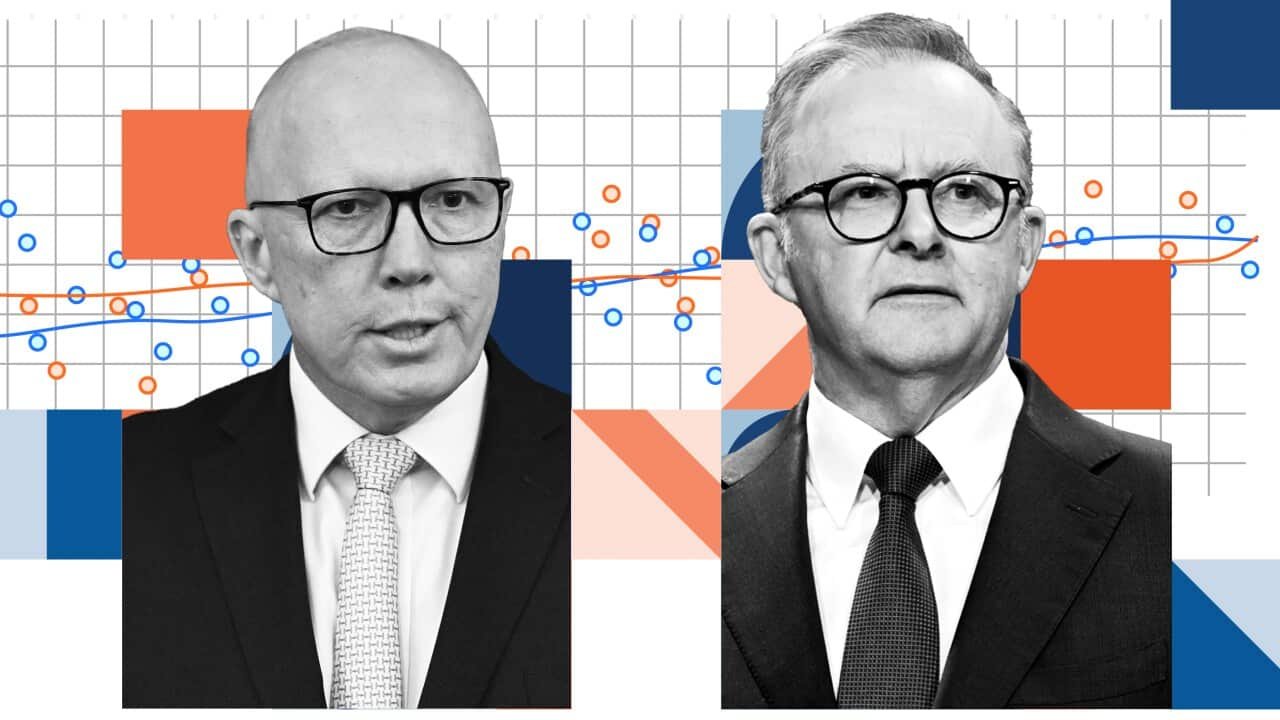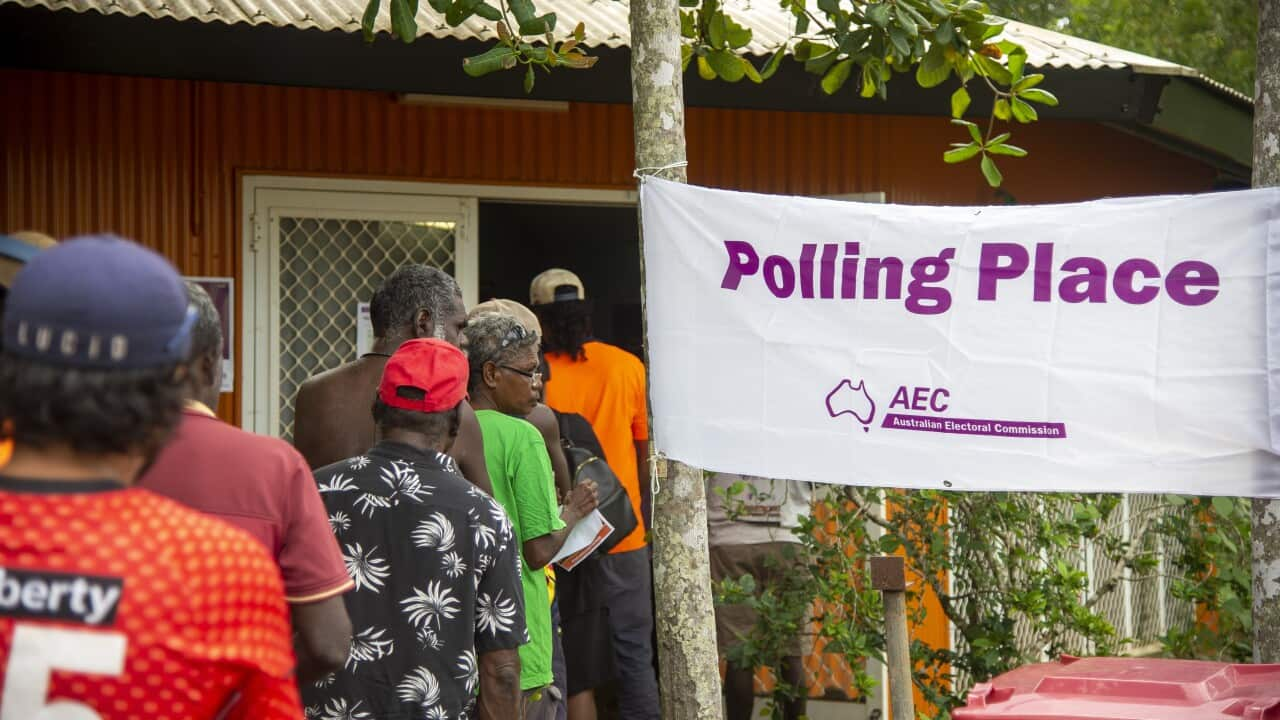The federal election is just a few weeks away and as campaigning continues, chances are you're reading more about polling.
But just what should you make of these surveys that predict, among other things, which party could form government, and voter sentiment?
SBS News spoke with Simon Welsh, director of research and reputation at pollster Redbridge Group, and Dr Kevin Bonham, an independent election and polling analyst, about what voters should be aware of.
What is polling?
Bonham said that political opinion polling "tries to present a snapshot of what voting intention is at the time that it's taken" and is "a fairly high level view of the voting intention contest".
Political polling can be presented in a few different ways and can use quantitative or qualitative data. Quantitative is numbers based, like "45 per cent of Australians will vote for [X]". Qualitative, on the other hand, is an analysis of trends that can’t be captured in clear numbers, like "Australians are increasingly concerned by [X]".
Both come under the umbrella of political polling and while quantitative polls tend to capture news headlines, both types are used in politics.
"Quantitative research is often used for making decisions about campaigns and campaign resource allocation”, Welsh said.
"The qualitative research is really used to deeply understand the voters and their priorities and their drivers, and that helps inform the messaging that the parties tend to take into campaigns."
Polling can be conducted in multiple ways as in-person interviews, phone interviews (with a real person), 'robopolling' (which is generally a computer calling), or online survey panels.
Australia has been more reliable to poll — but that’s changing
Compared to countries like the United States, Australia’s compulsory voting system has historically meant that polling was more reliable.
In a voluntary system like the US, pollsters have to attempt to analyse the voting intentions of the population likely to vote.
In a compulsory voting system like Australia has, they could rely on electoral data and decrease variables.
But things are changing.
"What we have seen over the years is the Australian electorate becoming far more fragmented", Welsh said. "[It has] changed dramatically and is accelerating into this election”.
In Redbridge’s research, across Australia there are changes particularly in increasing generational differences, an increase in ethnic/cultural diversity, differences between regional/rural/urban voters, and a change in the demographics of outer suburban electoral seats.
“[20 years ago], you could run those polls,what we call horse race polls, where you had Labor versus Liberal and you'd get a two-party-preferred kind of projection."
"They no longer mean a great deal because of the fragmentation of the communities."
In polling, two-party-preferred is a measure that shows how votes would likely fall between Labor and the Coalition after preferences from minor parties are distributed
The way pollsters are gathering data is also changing
This federal election, Millennials and Gen-Z voters will outnumber Baby Boomers for the first time.
Polling groups normally gather data through phone calls. But some surveys have suggested that younger people, particularly Gen-Z, don't like speaking on the phone.
Pollsters are conscious that this risks phone collected poll data skewing older and, generally, more conservative.
This has led to online polling as a more reliable and all-rounder resource, especially with limited resources, but increasingly common models for polling are still under question.
Multilevel regression with poststratification, or MRP, is a newer method for polling. This takes a pool of responses and, analysing the demographics of respondents, applies those patterns to help predict similar areas.
LISTEN TO

Path to Coalition victory narrows in 2025 election, polling suggests
SBS News
05:53
Bonham is curious about the use of MRP, saying: "They're not based on samples of the seats themselves and they're a more complicated model.
"This is still a bit of an experiment in Australia, but it's interesting to keep an eye on, and see how it goes. It's becoming more popular because for a number of reasons, including that individual seat by seat polling has been doing poorly for quite a while."
While Bonham is curious, Welsh said that the "MRP model is probably where the future of polling is going to lie".
While emphasising the "human effort" needed to accurately interpret data, he added that "seat-by-seat polling has become so difficult because you really are relying on some form of phone-based polling", which can be difficult particularly among younger voters.
"But understand that MRP is predictive modeling and not direct research with voters," Bonham said.
What do voters need to be aware of when reading about polling?
In reading polling data, both Bonham and Welsh want voters to pay attention to two things: Methodology (the way data is collected), and where the data was collected.
Methodology, like phone calling, can mean only certain demographics engage or models like MRP means some seats could be predicted with little or no direct voter engagement.
Welsh wants voters to consider where the polling was conducted, warning that a broad national sample might miss important local, social, and community differences.
Bonham also encourages people to consider who conducted the poll.
"Although [many] national polls are conducted using fair questions, there are a lot of polls swirling about, often on a local level or by less well known pollsters, that use suspect questions and they get poorly reported in the media," Bonham said.
This can include things like '', which is a tactic to persuade voters to a certain candidate through a biased style of questioning and that Welsh calls "a concern" for the polling industry.
Other experts have said to look at the margin of error — the range that poll results might vary due to chance. For example, if a poll indicates Labor leads the Coalition 51 to 49 per cent on a two-party-preferred basis with a margin of error of plus or minus 3 per cent, the real result could be as close as 48 per cent Labor v 52 per cent Coalition or as wide as 54 per cent Labor v 46 per cent Coalition.
If these detail are not included in a media report, a methodology statement may be available on the polling group's website.
Ultimately, Bonham encourages voters to "read lots of different polls, [and] don’t take any one poll as gospel."
He and Welsh also both acknowledge that voters might have to use a healthy level of scepticism with media commentary, personally checking whether the information comes from polling experts or potential ulterior motives.
Bonham said "[polling] can be spun for one side or the other — just to get sales."


